Affiliate disclosure: This post may contain affiliate links. Please see our Privacy Policy.
Lemon balm mead is a delightful herbal honey wine that captures the essence of summer for year-round enjoyment. This simple herbal brew is easy to make at home and is the perfect way to use a bumper crop of lemon balm.
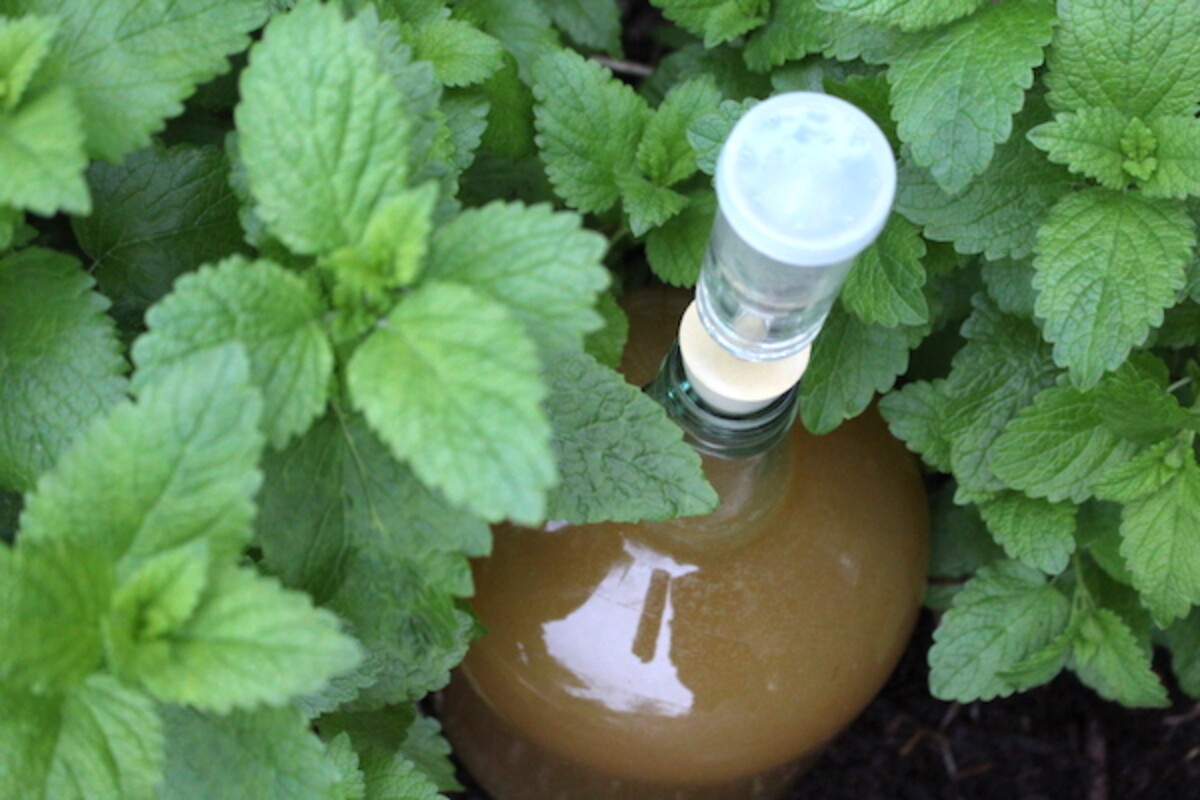
Our lemon balm patch is especially prolific, and it’s one of the few things that really loves our shady, cool and wet Vermont soils. I’m always on the lookout for new lemon balm recipes, and when my friend Amber sent me a copy of her new book Artisanal Small-Batch Brewing, the very first thing that caught my eye was her recipe for Lemon Balm Mead.
Here’s how it’s described in the book: “Also known as ‘Sweet Melissa,’ lemon balm is a heart-lifting, aromatic herb from the mint family. If you’ve ever grown it, then you’ll know that it is vigorous and you often have more lemon balm than you know what to do with. Along with teas, cookies, syrups and sugared leaves, you can use up your harvest with a gallon of bright, invigorating mead!”
In truth, there are plenty of epic homemade wines, ciders, and meads in her book. Shortly after I made this brew, I started a batch of pineapple mead inspired by her recipe, and the recipe for rose cider with fresh rose petals is calling my name. This fall, I’m going to make her dark ginger cider, and I’m going to try her technique to make homemade perry (pear cider) and pomegranate wine.
There’s even a recipe for Scarborough fair wine, with parsley, sage, rosemary, and thyme. I’m a big lover of herbal fermentation, and this book has plenty to catch my eye. Still…lemon balm mead is too good to pass up.
(If you don’t have lemon balm, it’s easy to grow from seed, provided you have a few Lemon Balm Seed Packets.)
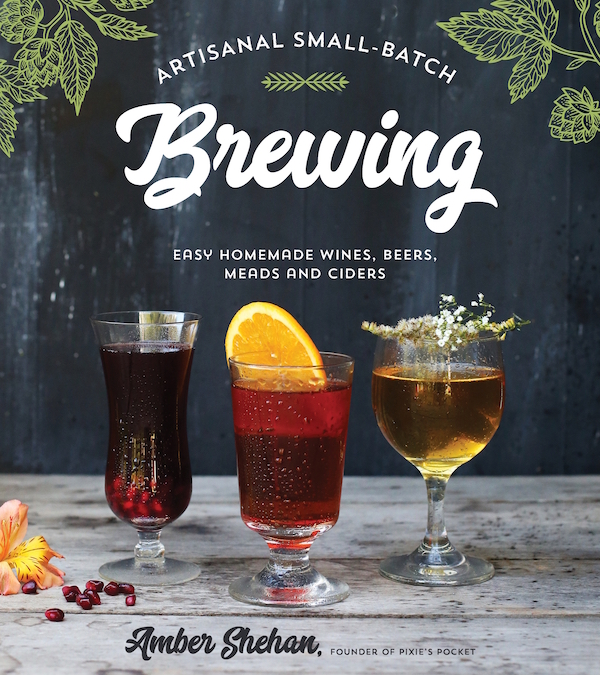
Lemon balm is a medicinal herb, and it’s traditionally used for calming anxiety and easing digestive issues. It’s generally taken for depression, stress, anxiety, and insomnia.
Infusing herbs into wine, mead, and ale was common a century ago and is a really lovely way to take your medicine. It also helps preserve the medicinal properties of herbs for year-round use. While lemon balm may grow like a weed in the summertime, it’s nice to have a bit put up when winter depression sets in up here in the north country.
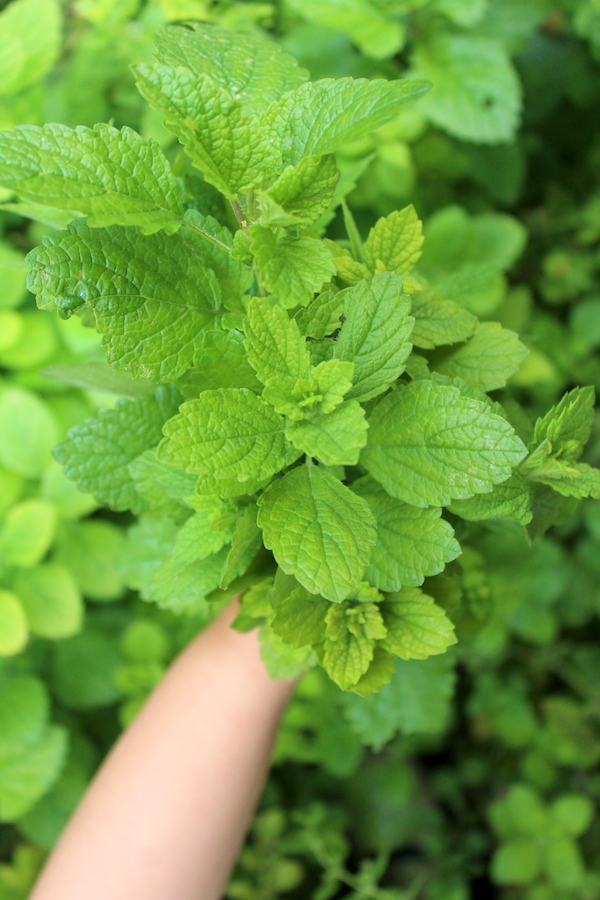
Generally, when I’m making a floral or herbal wine/mead I opt for cold infusion, as I did in my dandelion wine and lilac wine. I’ll chop the herbs finely and place them into the fermenter with cooled syrup and yeast. I allow them to infuse during the primary fermentation step, and then I filter them out after about a week and put the demijohns into the basement for a month or two so the yeast can finish their work.
This recipe is different though, and honestly, much easier to work with. There’s no lemon balm in the fermenter to clog up the water lock, and there’s still plenty of lemon balm flavor.
Start by bringing the water to a boil, then add honey and stir to dissolve. Next, chop up fresh lemon balm and fresh lemon and place them in the hot syrup for about 15 minutes to infuse.
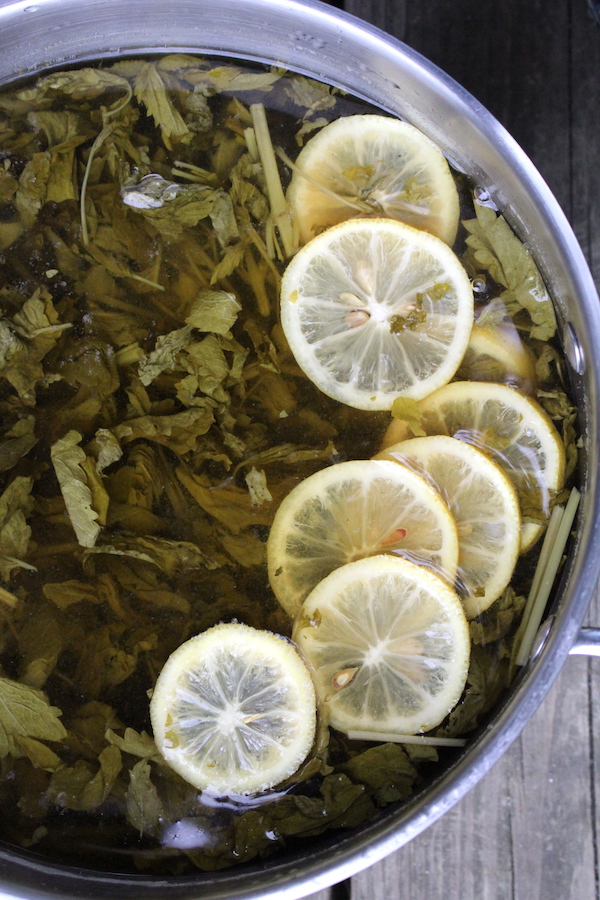
Amber’s recipe is for the folk tradition of mead making, using natural ingredients instead of winemaking additives. You won’t find any chemical yeast nutrient or tannin powder in her recipes. She opts for a handful of raisins to help nourish the yeast and a bit of strongly brewed black tea for tannin to balance out the body of her homemade wines.
Normally, I’m right there with her. I use yeast nutrient when I want a really clean flavor without any caramel overtones from the raisins, like in my lemon wine.
The problem this time though, is that my two toddler raisin fiends ate up all the raisins in the house. So here I have the perfect recipe for a natural herbal mead, and I’m adding yeast nutrient to it out of necessity. Oh well.
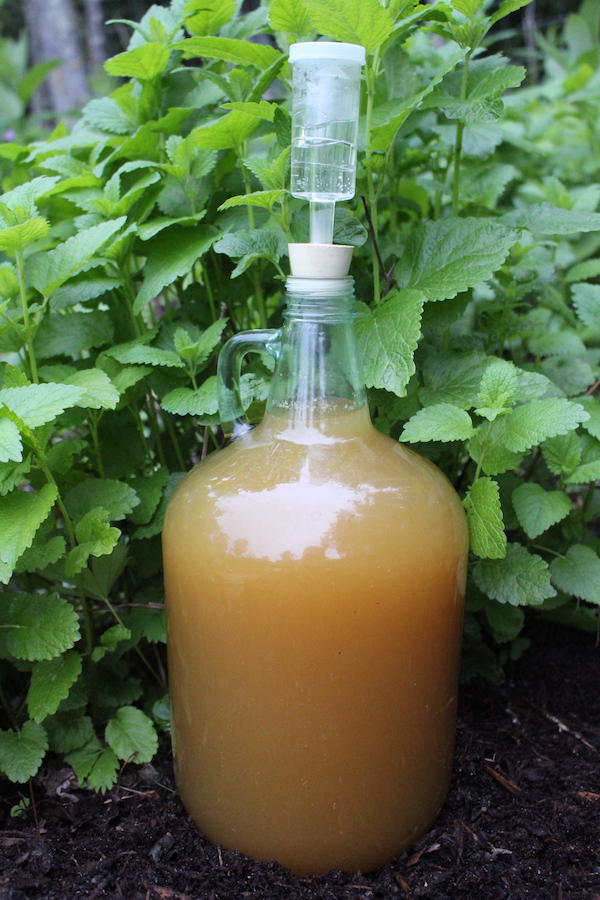
No judgment, either way, use whatever suits your tastes. Feel free to add raisins or yeast nutrient based on what you have on hand, but either way, the yeast needs more nutrition than honey can provide.
They need micronutrients that’d normally be present in wine grapes, and they’ll work very slowly without them. Traditionally mead was a very slow ferment, but with a bit of nutrition, the yeasts work a lot more efficiently.
The recipe below is only a slight adaptation of the recipe from Artisanal Small Batch Brewing, and I’ve given instructions for using either natural additives (raisins, etc) or winemaking chemicals for a cleaner finished flavor. As with all homemade mead, it’s best to allow the brew to bottle condition for a few months (or a few years) before enjoying.
If you’ve never made mead before, check out this primer on making small-batch wine and mead before you get started.
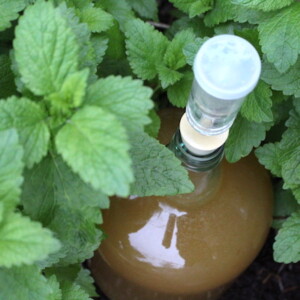
Lemon Balm Mead
Ingredients
- 1 gal water, divided
- 1 lemon, sliced
- 1/8 cup raisins, chopped, or 1 tsp yeast nutrient
- 1 cup strongly brewed black tea, or 1/4 tsp tannin powder
- 6 cups Lemon Balm, Fresh Leaves, gently packed
- 3 lbs honey, about 4 cups
- 1/2 Packet Lalvin D-47 yeast, or 1/2 packet champagne yeast
Instructions
- Heat 3/4 gallon water in a stockpot to near boiling and remove from heat. Add sliced lemon, brewed black tea, and honey.
- Stir to dissolve the honey.
- lemon balm leaves.
- Add the lemon balm leaves and allow to infuse for 15 minutes, then strain the herbs and lemon.
- Pour the strained mixture into a 1 gallon carboy using a funnel.
- Add cool water to top off the brew, filling to the neck of the fermenter.
- When the mead is at room temperature, add the yeast.
- Cap with a bung and airlock and allow the mixture to ferment for 1-2 months.
- Siphon the mead into a clean carboy, leaving any sediment behind. Re-cap with a bung and airlock and allow the mixture to ferment for another 1-2 months.
- Bottle using wine bottles and corks, and allow the herbal mead to bottle condition for at least 1 month (preferably longer) before drinking.
Notes
More Mead Recipes
Looking for more easy mead recipes? Try any of these:
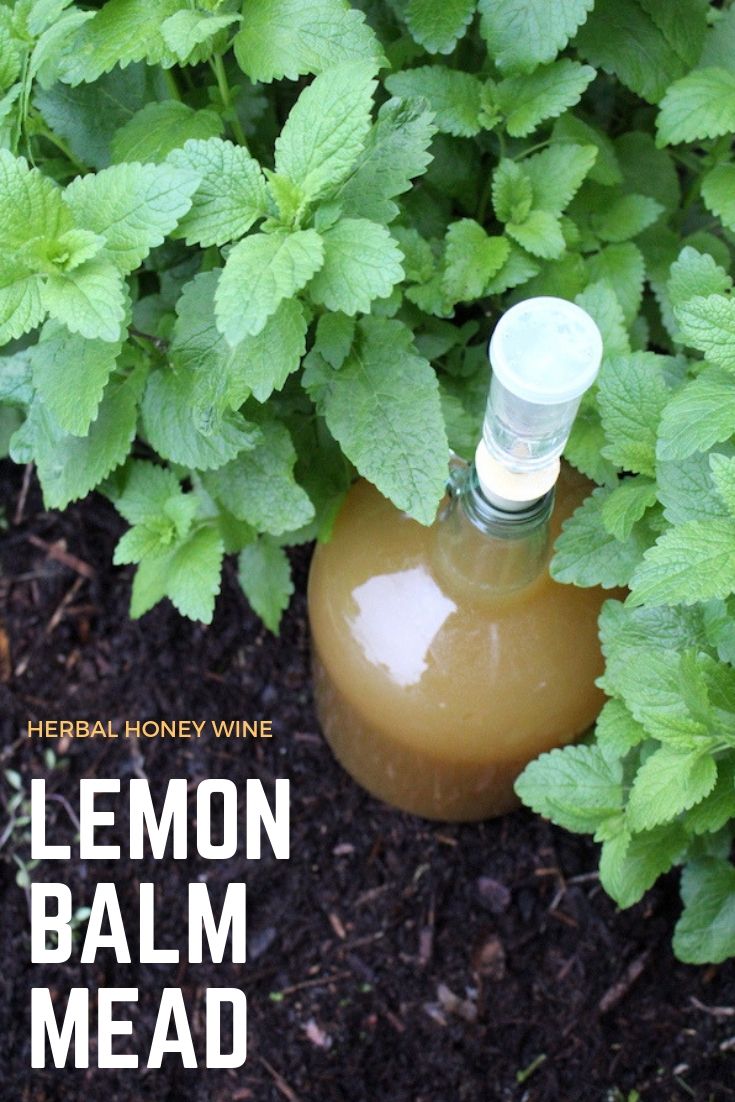



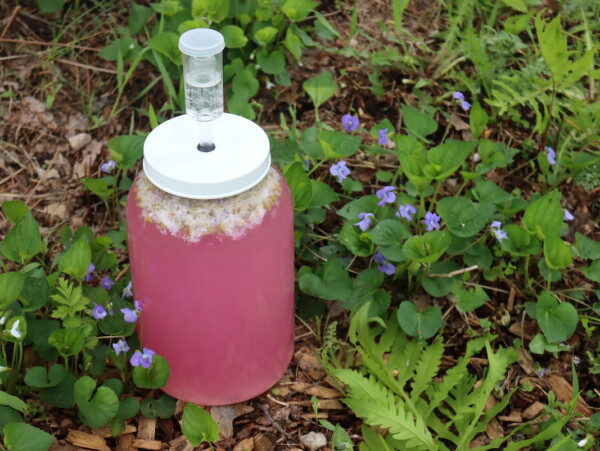










I made this early today and I already have foam on top and bubbles in the airlock. I put the yeast straight in and I saw where you said it had to be dissolved in water first. Is it going to work ?
Yes, that’s perfectly fine and normal. Some types of yeast are shocked a bit by going right into a sugar-y solution and do better given a chance to wake up first, but others don’t mind. It sounds like yours is bubbling right along as expected.
Once you open up a mead that is done fermenting (and aging) how long is it good for? I assume it should then be refrigerated? Thanks!
It’s about the same as any normal bottle of white wine. It’s best within a few days, but keeps longer if you keep it in the fridge and tightly sealed.
Hello,
For the lemon balm, can I use dried leaves that are commonly used for tea?
Thanks
I haven’t ever tried it with dried lemon balm before but it will probably work fine.
The notes at the bottom of the recipe state “The original recipe notes that this herbal mead is best made with fresh lemon balm, and that dried lemon balm makes the mead a bit too tannic and bitter.”
What about the fact that honey becomes toxic when heated above 95°F? Shouldn’t be added at the end when the mixture cools down a bit more?
Honey doesn’t become toxic when it’s heated above 95 degrees. Bees live (and make honey) in areas where the honey in the hive goes over 95 degrees…that just doesn’t make sense. Even “raw” honey is usually warmed well above 95 degrees when it’s packed, to ensure it flows into the jars. Most foods are still considered “raw” until they’re heated much warmer than that, usually somewhere between 114 F to 140 F, depending on who you ask. But either way, it’s not toxic. But, that’s beside the point.
To your direct question, yes, you can add the honey at the end, just make sure the water is warm enough to fully dissolve the honey. Honey contains live yeast, so you’ll have wild yeast in your mead this way, which some people like to avoid, but it’s a personal preference. I’ve made it both ways, and both are lovely.
Hi Ashley,
Thanks for this resource! I’m about to siphon over to my second carboy but all my raisins are at the top. Any tips or tricks for avoiding disturbing the mead too much but getting out the ‘gross bits’?
Thanks!
You could just skim the raisins off the top before siphoning if you need to.
Hi Ashley, does the strong black tea result in a caffeinated beverage? I don’t drink caffeine after noon as I am very sensitive to it and wouldn’t sleep at night.
Thanks, Daun
The tea will certainly add a bit of caffeine to the beverage but it would be a small amount.
Hi Ashley,
I just found your recipe,looks great. Can I leave the carboy to ferment outside? And I live in Florida, so it gets really hot. Will heat cut the fermentation time in half?
Thanks.
Julie
The warmer the temperatures, the faster the fermentation will happen. Let us know if you decide to give it a try.
Hello!
Can I add currants instead of raisins?
Thanks
I’m not sure. I haven’t personally tried it but if you decide to give it a try let us know.
Hi again – I did some research and the yeast I have is D47, which CAN be used as a champagne yeast.
Thank you!
Renee
Thanks for sharing that.
Hi Ashley, I hope you’re still active on your site. I know this post has been here a while.
I’m brand new to mead making (kit arrived today) and I bought it to make your lemon balm recipe! I have two questions:
1. Can I multiply the recipe by 5 for a 5 gallon carboy? The kit is a 5-gallon kit.
2. My yeast is Lalvin (e49). Do you know if that will work in this recipe?
Thank you in advance for your help!
Renee
Yes, you can definitely multiply by 5 to make a bigger batch.
Thank you for this recipe, and for the lead on the book. I had to have it!
I started my mead two weeks ago and realized today it was trying to blow the top off the airlock. When I racked it I had to do a wee taste test. Being mead I expected it to basically taste like cat’s ass, but it was already amazing! The scent, the sparkle, the flavor…holy moley! Really impressed the hubby too, as I usually stick to wine and he was the mead maker (not for years though). I can’t wait until it’s ready. No, I mean really…now I’m not sure I can wait that long!
Making this right now and fermentation is almost complete! Do you stabilize the mead once its done? Or is that not necessary? Thanks for this recipe!
I generally don’t stabilize meads or homemade wines. I just give them plenty of time in secondary or rack them a few extra times to ensure they’ve completed the fermentation on their own before bottling.
Hi! I’m worried I might have messed up on this one. My mead is getting ready to be racked in two weeks and I just realized I forgot to add water to my airlock this entire time. Do you think my batch is a lost cause? Thank you for your help.
Add water to it and if it starts bubbling away, it should be fine!
Hi, Ashley.
I am wondering if the lemon rind night give this a bitter edge. That’s offset by the honey maybe?
Thanks!
There’s not enough rind in the batch to really cause any bitterness with that much honey.
Hi! How long does this keep? Does it need to be refrigerated?
Once it’s bottled, you can age it for years.
Hi! I’ve never tried this but I have a lot of lemon balm and a gallon carboy and airlock waiting to be used.. I want to use the raisins but not sure when to add them based on everything I’ve been reading here and elsewhere. Also with the addition of raisins do I still add the champagne yeast? Am I missing something? Also I’m concerned that I may blow something up 😆 I’m new to this but there’s so much lemon balm I hate for it to go to waste. Thanks for your time and all and any info you can add!
No worries! The raisins replace the yeast nutrient, you’ll still need the yeast itself. It’s less exact than you might think, so I wouldn’t worry too much about blow it up. People were doing this in caves thousands of years ago, so you’re way ahead of it in terms of equipment. Add the raisins directly to the carboy with the strained liquid, they need to be in there through the primary fermentation to feed the yeasts. When/if you rack it into a secondary, strain out the raisins at that point. Good luck, and let me know if you have any other questions as you move through the process.
Thank you so much!